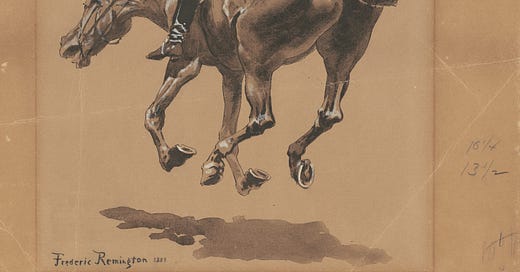Are You a Best-in-Class Leader?
We all pursue excellence, but some leaders and company cultures strive for perfection, foster innovation and expect the absolute best from their employees. Find out if you're Best-in-Class leader.
(Photo credit: On the Bridle Path Central Park New York, Frederic Remington, 1889)
She was smart, hard-working and eager to learn. Our coaching sessions got off to a great start. But it wasn’t long before Sue and I had this conversation:
Sue: “I’m so frustrated with the people who work for me. They don’t listen. They keep coming to me with the same issues, over and over again.”
Me: “Why do you think that is?”
Sue: “I don’t know. Maybe we’re hiring people who aren’t cut out for the job. Maybe they just don’t care to learn. I’d think that after they had been in the job for a few months, they’d ‘get it’ and I wouldn’t have to babysit them. We’re a top-notch company and we deserve to have people working here who strive for excellence.”
Me: “Sue, it’s possible you are an ‘A Player’ working with a ‘B Team’ — so what are your options?”
Sue: “Well, I think I either need to adjust my expectations or work harder to coach them to meet higher standards. Maybe both!”
Traits of a Best-In-Class Leader
Sue was right. They were a first-tier company and for the most part, their employees reflected that. But she had some work to do leading her people to meet those expectations. And she did need to adjust her perspective — they weren’t going to magically change overnight.
Sue was a “standard-setter” leader. According to William E. Schneider in his book, “Lead Right for Your Company’s Type: How to Connect Your Culture with Your Customer Promise,” this kind of leader is right at home in a “Best-In-Class” culture. Expertise is the cornerstone of these organizations and excellence is the driving force.
As he says in the book, “So, if you want to work in a best-in-class enterprise, be ready to work for someone obsessed. Standard-setter leaders strive for perfection and want their employees to do the same. They set exacting expectations. They are taskmasters. They want everything planned out in detail and they often want to pass judgment on every detail. They push the limits and have a very hard time accepting the message ‘it can’t be done.’”
These leaders are strategists, challenging, competitive, they set high standards and foster innovation.
In the DiSC assessment, as well as other behavioral profiles, the personality types who match this leadership profile may be the Conscientious or Dominant styles, and possibly both.
The Conscientious style can include these traits: analytical, reserved, precise, private, systematic, challenge assumptions, skeptical, can be overly critical with a tendency to overanalyze.
The Dominant style is more direct, firm, strong-willed, forceful, results-oriented, strives for immediate results, challenges themselves and others but may be impatient and insensitive.
Qualities of a Best-In-Class Culture
In this type of hard-charging environment, it’s critical to be right. These organizations focus on future possibilities, vision, competition, new ideas and one-of-a-kind solutions.
They include companies like Neuralink, Starlink, Apple, Xerox, Sony and law firms where it’s either win or lose. Second place results in a court case don’t count. Rockets either launch or they blow up in mid-air. Using a robot to surgically insert an implant into a part of the brain isn’t a hit-or-miss procedure. Excellence is a necessity.
As Schneider says, “In a best-in-class enterprise, customers are paying for products and/or services that are distinctive and unmatched. Expertise plays a role in all four enterprises, but it is the central driving force for a best-in-class enterprise…it provides products and/or services that continually redefine the state of the art and are based on unique technology or know-how.”
This is a culture where it’s critical to think things through, plan for every contingency and apply pressure until they get it right. Hard analysis is key. And they attract innovative people who aren’t afraid to test the boundaries, but with the expectation that they’ll hit the mark.
Schneider continues, “This culture takes nothing for granted. Talk is cheap. Everyone is from Missouri, the ‘show me’ state. Performance has to be demonstrated and proved. Analytical capability often overshadows interpersonal capability. This culture has to verify its progress, using factual data, every step of the way.”
Thus, the Conscientious personality style motto, “Prove it to me” helps to drive these organizations to achieve accurate outcomes. And the Dominant style motto, “Git ‘er done!” is focused on overcoming obstacles to get results.
Sue had a decision to make. Would she have the patience and energy to drive her team towards higher levels of excellence, or move on to another organization where her “A Player” characteristics would be put to better use — a place where her standards are expected and rewarded?
High achievers like Sue don’t usually stick around if forced to play with the “B Team.”
Know of someone who’s in a leadership role or wants to get there? Send them this article or a link to all my other posts. They’ll thank you for it!





I agree. She needs to work with an "A" team. If you're going to be efficient and leading, you can't have others working for you who don't want the same thing. You'll just be dragging them toward the finish line and you can't perform at the top level when dragging everybody else. The horse (you) will be driven to a heart attack by the cart. Great post, Laura.